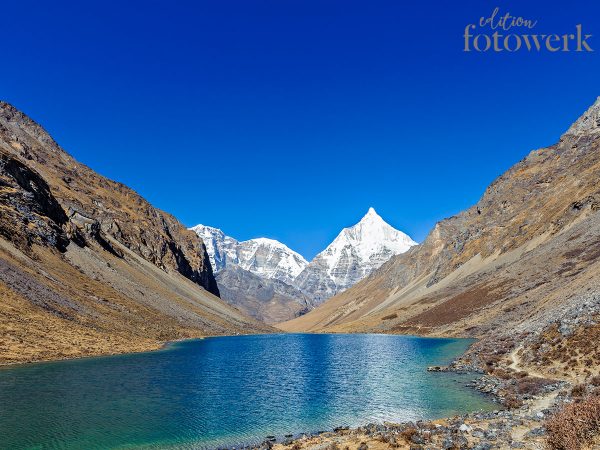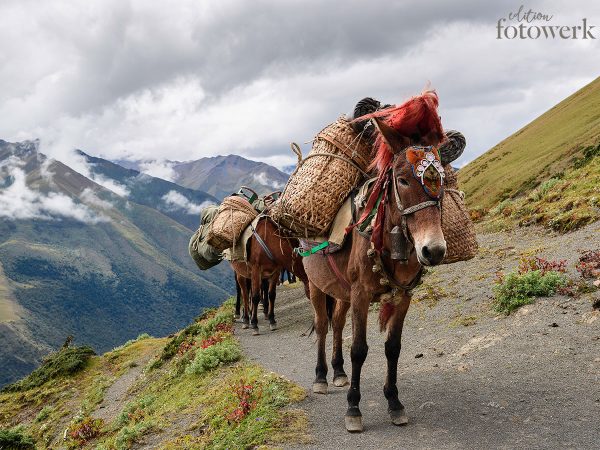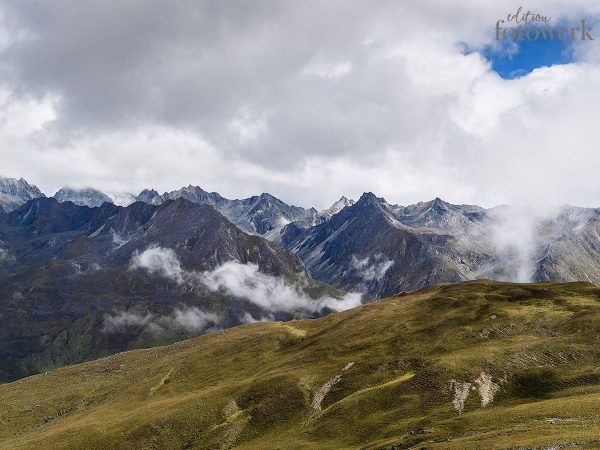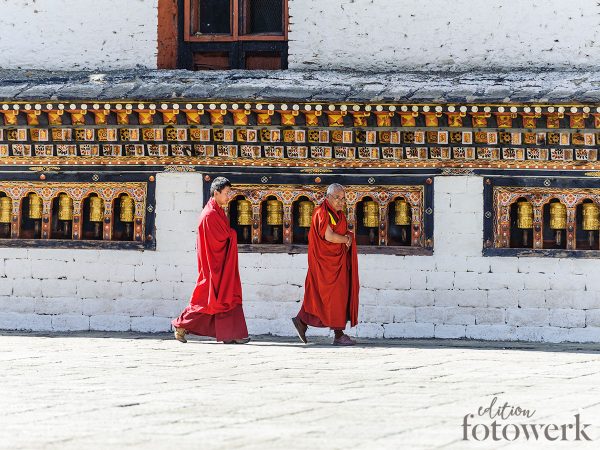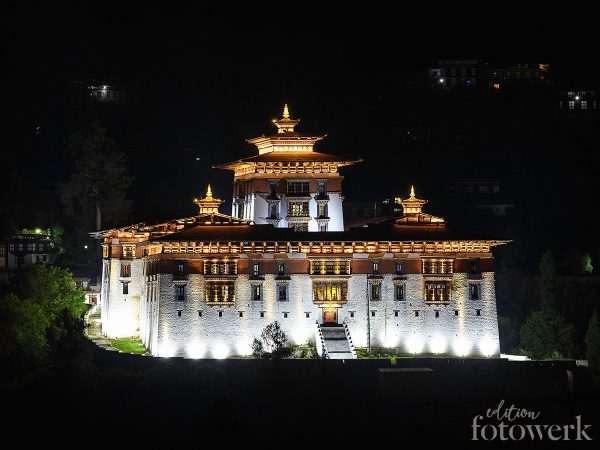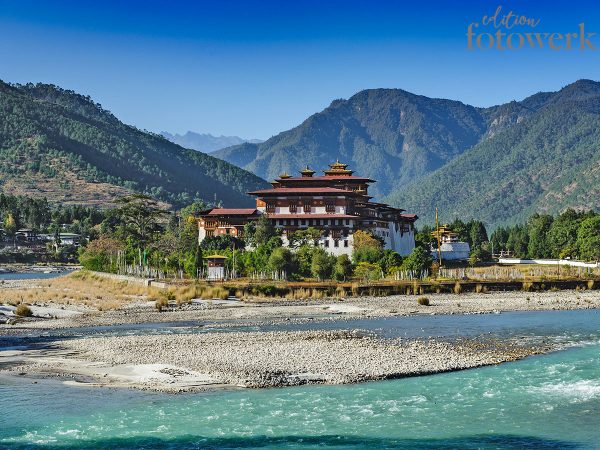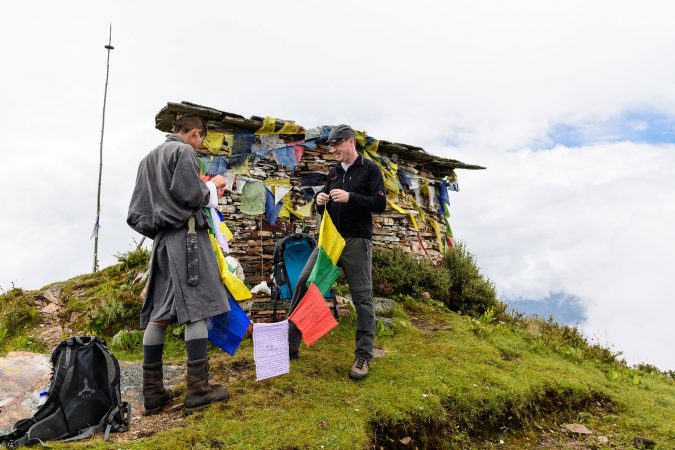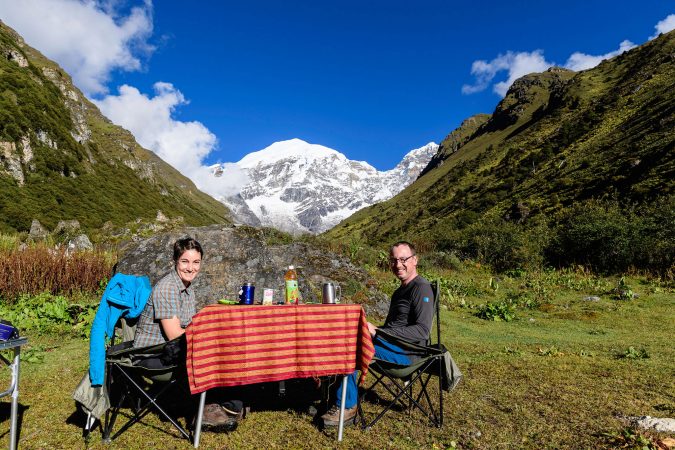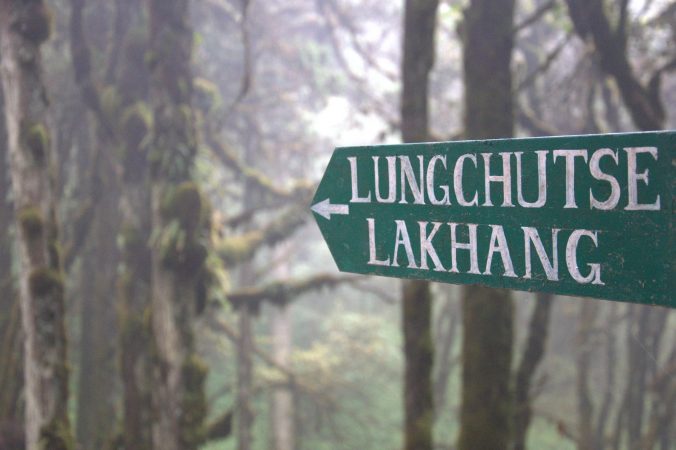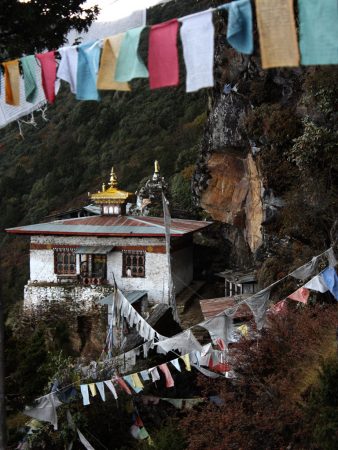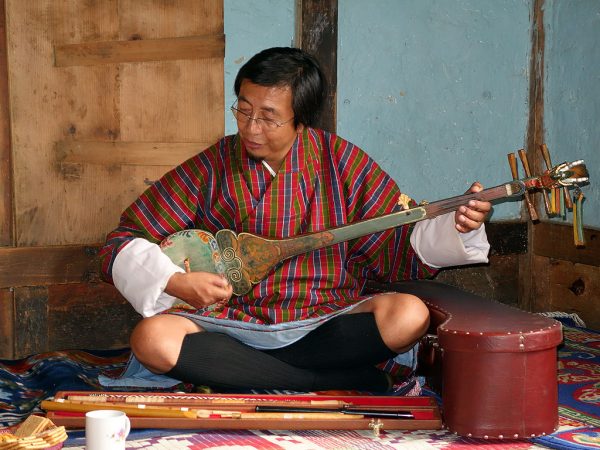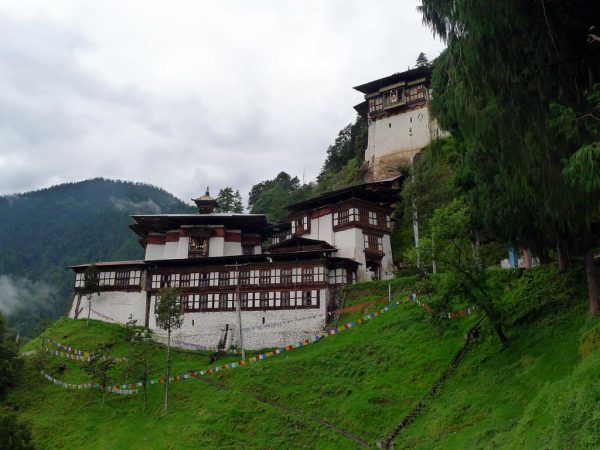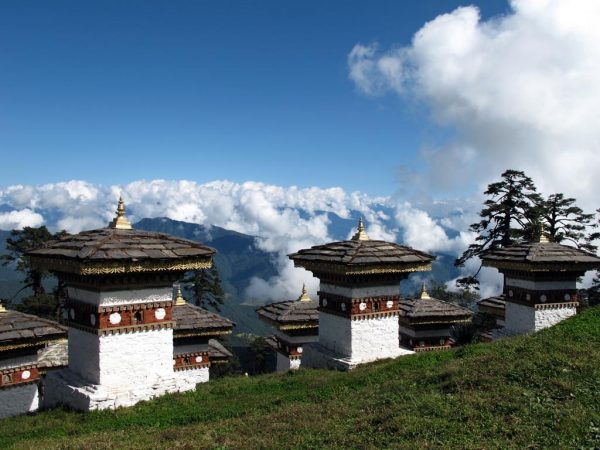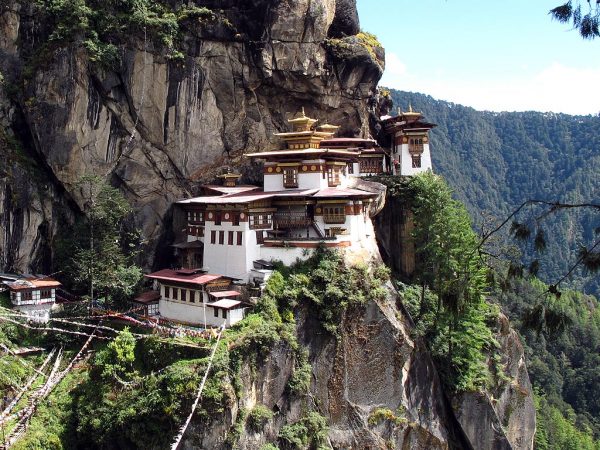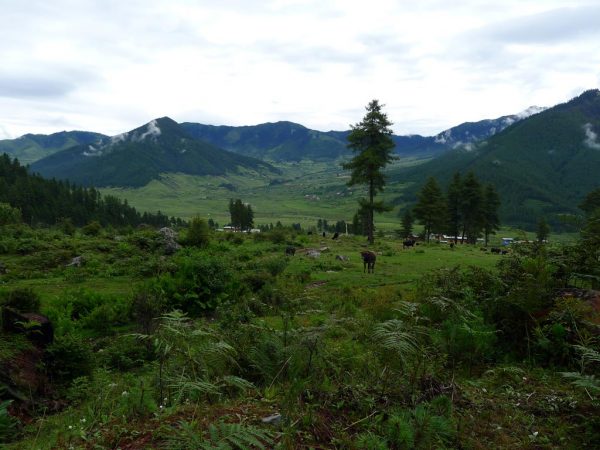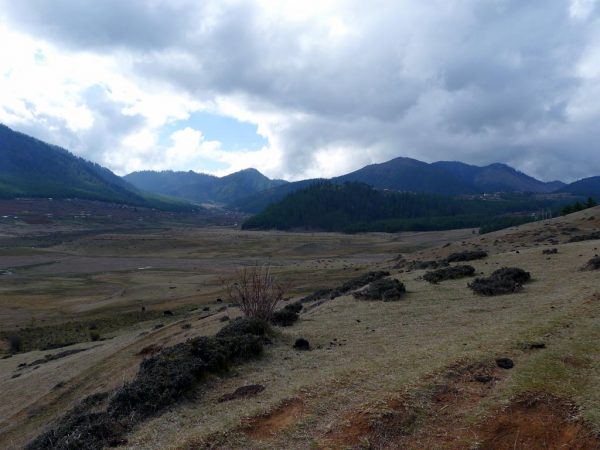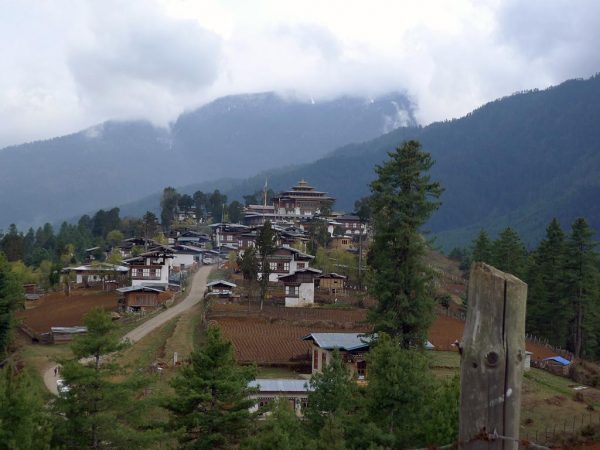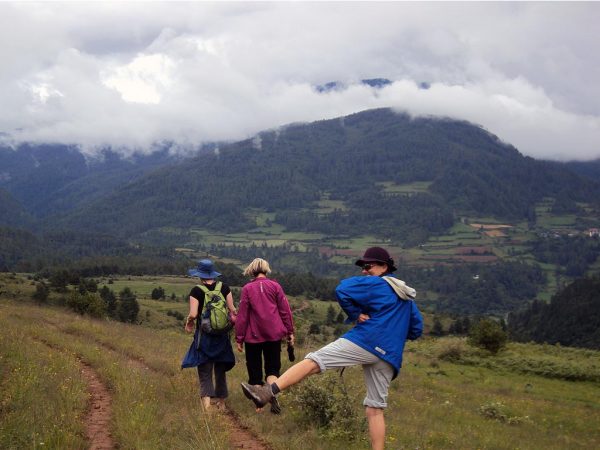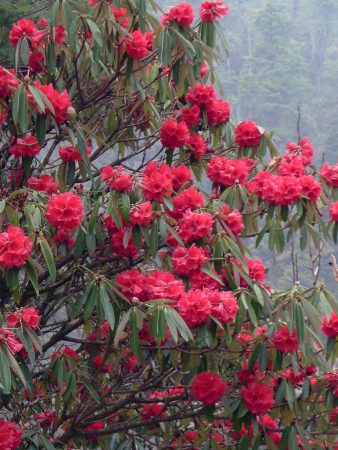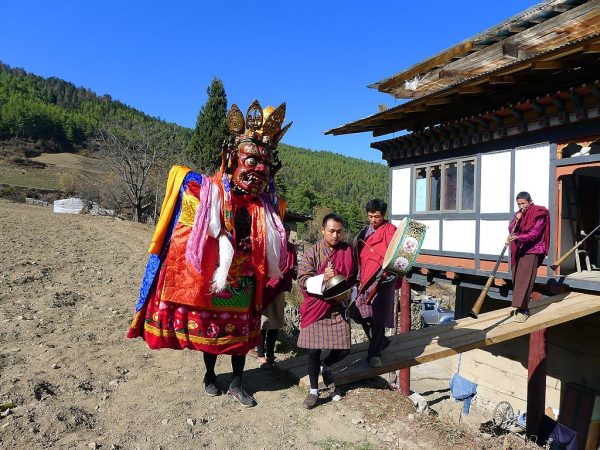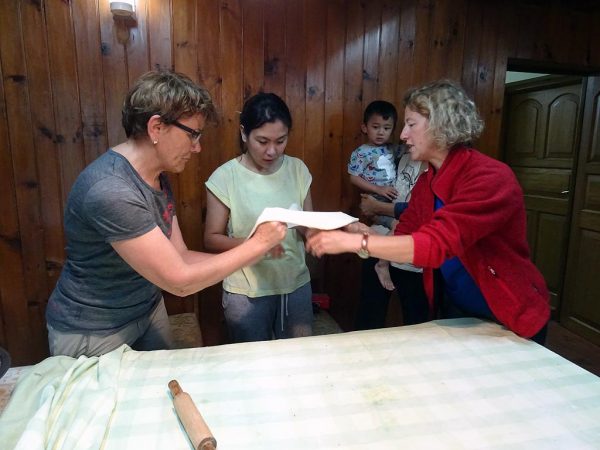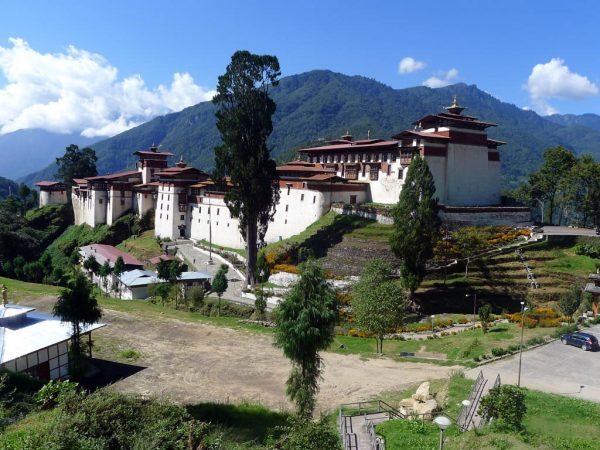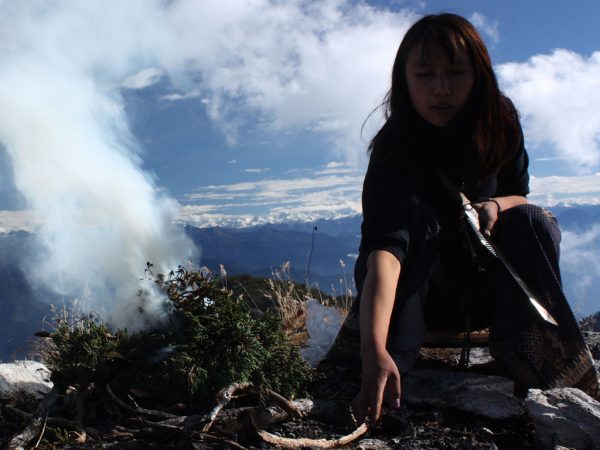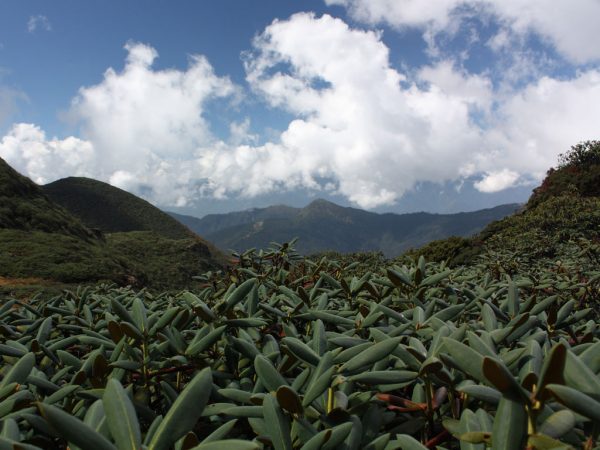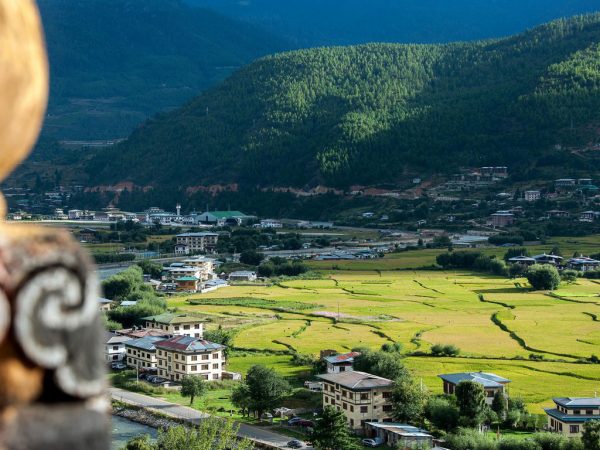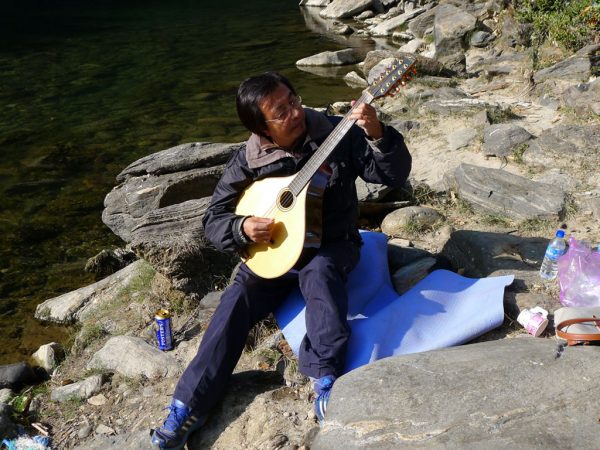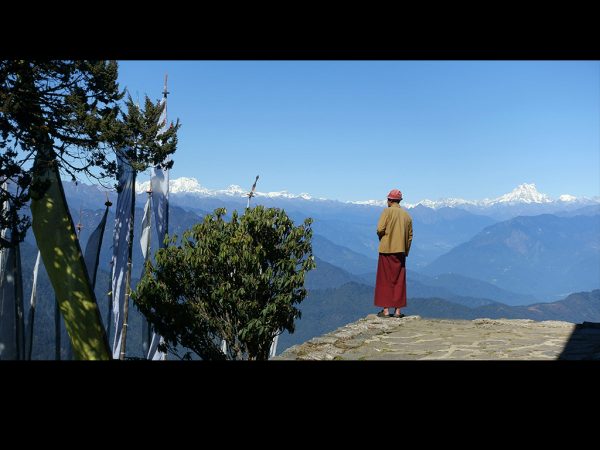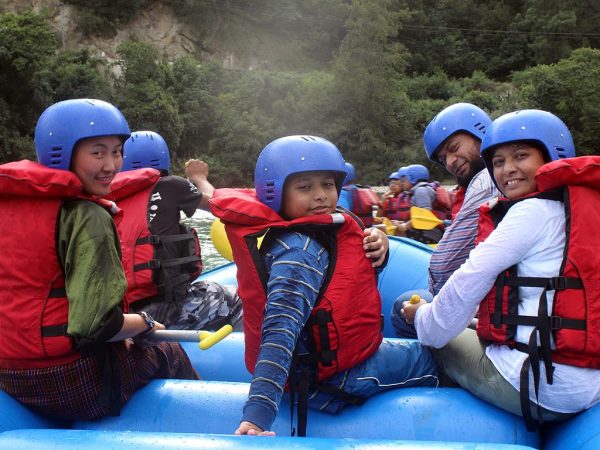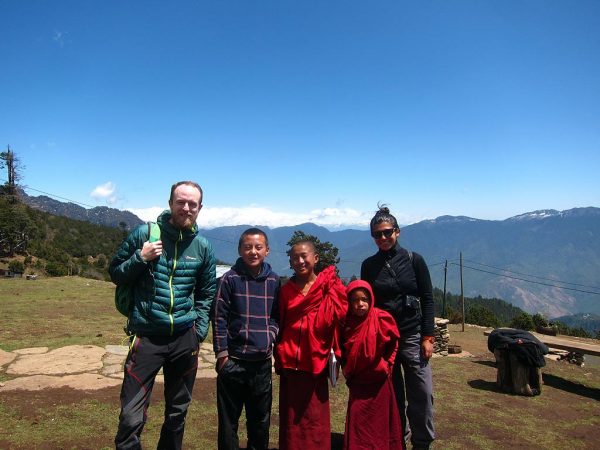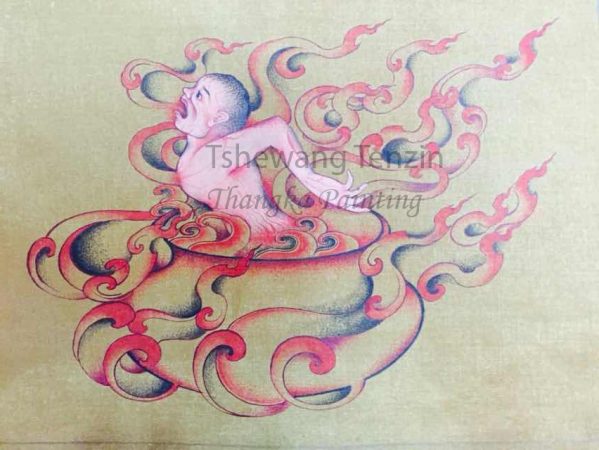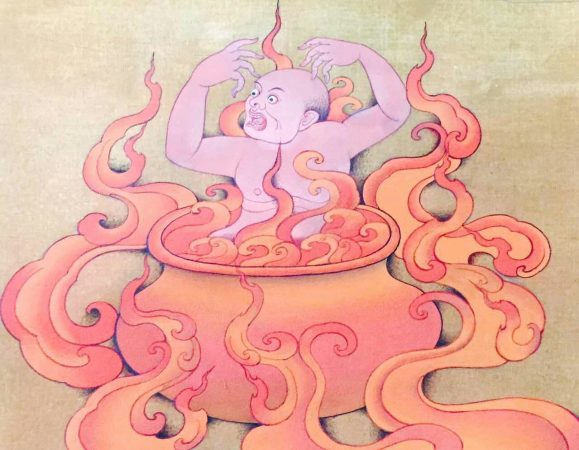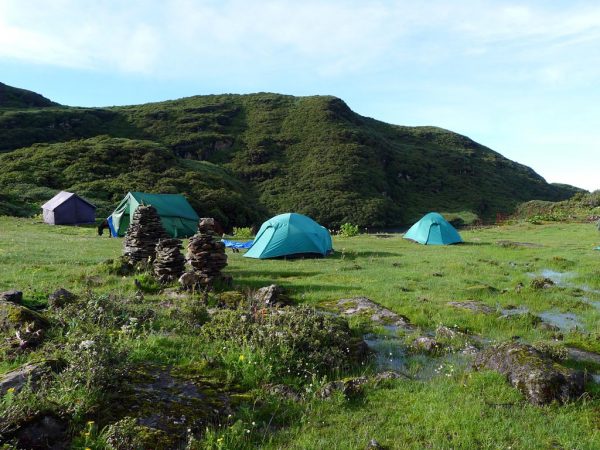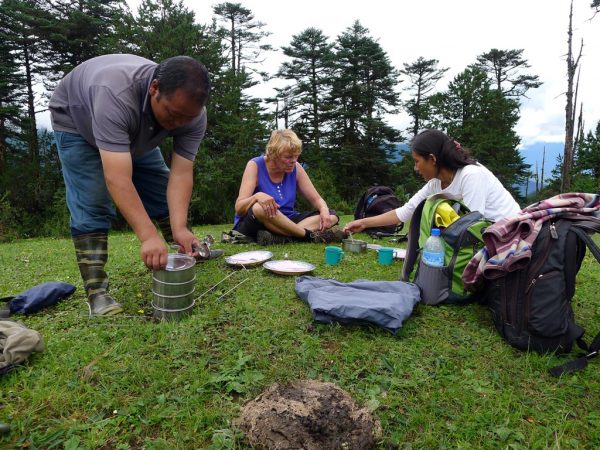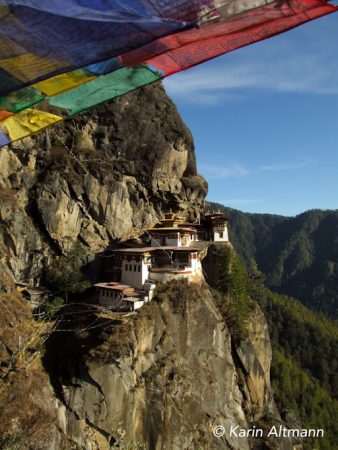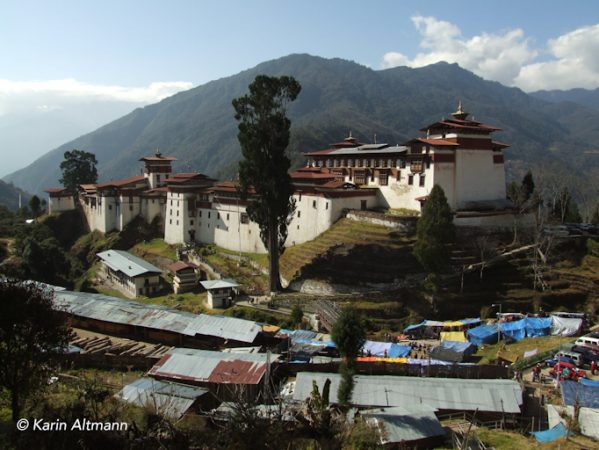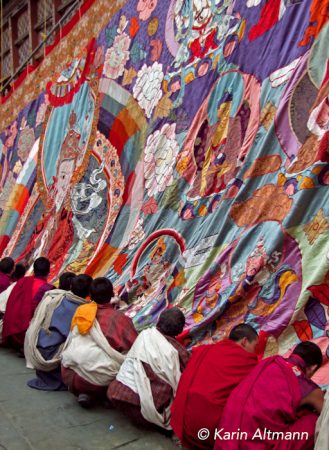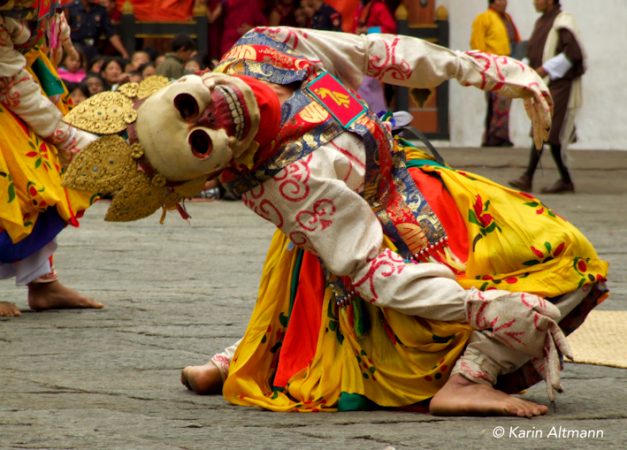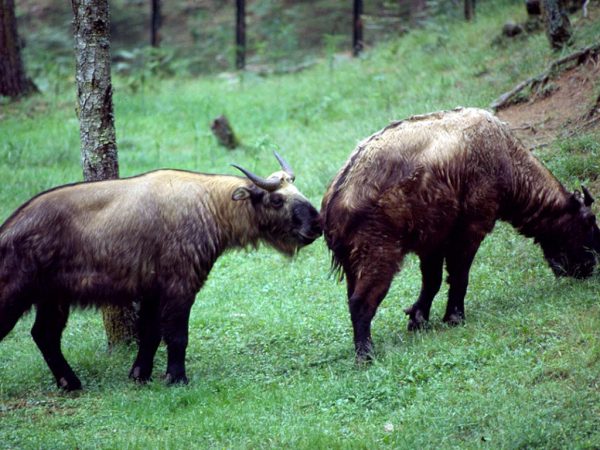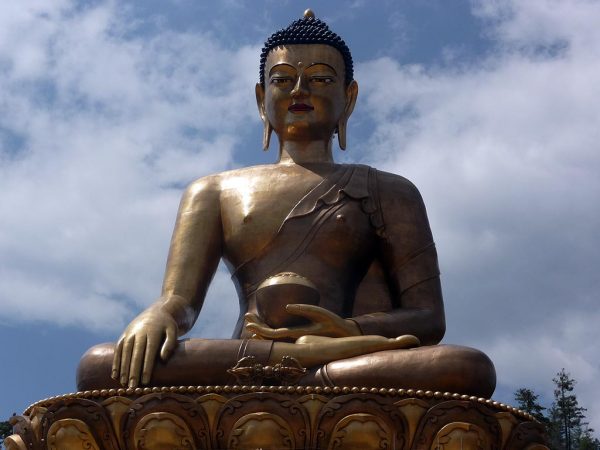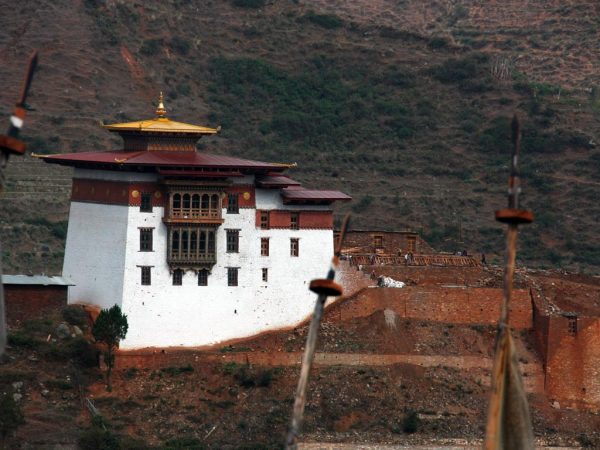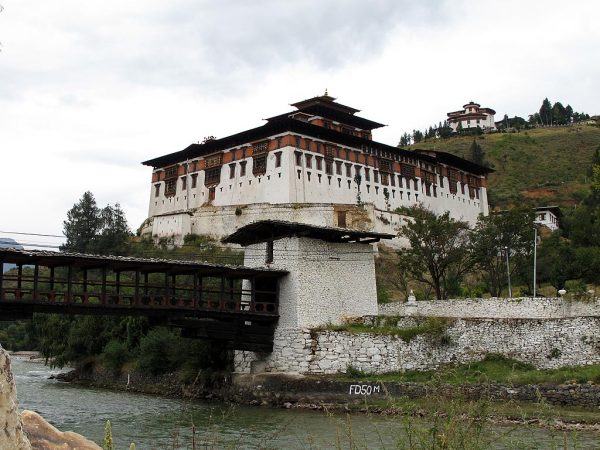“Zhung” – The administrative Centre
West Bhutan includes Thimphu, Paro, Haa, Wangdue Phodrang, Punakha, and Gasa. This part of Bhutan is considered more developed than the rest of the country. It offers many cultural sights and festivals during high season such as Tshechus (annual festivals with mask dances), the summer festival of Haa, or the Takin Festival in Thimphu, the mushroom festival in Geneka,and many more. You can also visit temples, dzongs (fortresses), and museums or attend a textile festival that brings to life the rich culture of Bhutanese weaving.
The West offers many well maintained hiking routes which range from a few hours to substantial long term treks. Thimphu has developed into a bustling capital where you can experience a different side of Bhutan due to rapid urbanisation over the past decade. You can visit galleries, meet Thimphu urbanites, a new generation, in various cafes around town which exist side by side with more traditional archery tournaments in the Changlimitang ground. Although Western clothing has become more common among youth and shop keepers, you will still find many locals in the traditional dresses, gho and kira, as it is mandatory to wear for civil servants in the offices.
Paro is the gateway into Bhutan by air and except for its quaint little town, Paro is still very rural. Paro is dotted with monasteries with great histories and legends, the most famous being Taktsang located high up the cliffs higher up the Paro valley.The valley of Haa has only very recently been opened to Tourism. This scenic Alpine valley is about 68km from Paro and can be reached quite easily driving through the Chelela Pass(3700m). Lechuna Heritage Lodge, a beautiful family home now a Heritage Lodge is located in this beautiful valley.
Punakha was the winter capital of Bhutan in the 1950s because of its warmer climes. Even to this day the central monk body migrate to Punakha for the six colder months of the year. The magnificent Pungthang Dechenphodrang (Punakha) Dzong where many famous events such as the coronation of the 5th King, the Royal weddings of the 4th and 5th Kings have taken place lies at the confluence of the rivers Pho(male) Chu and Mo(female) Chu.
Dzongs, Monasteries and Temples
PARO
Paro Taktsang
Taktshang is one of the most venerated pilgrimage sites of the Himalayas and contains 13 holy places. Guru Rinpoche was said to have arrived riding on a tigress (a form taken by his consort for the occasion). In his form as Dorje Droloe (the tantric, terrifying manifestation), he subjugated the Eight Categories of Evil Spirits by using the religious cycle of the Kagye. Many Tibetan saints came to meditate here, and the first sanctuary to be built here dates back to the 14th century.
Drugyel Dzong
This Dzong was built in 1647 by Zhabdrung Ngawang Namgyel It burnt down in 1951 due to a fallen butter lamp. The ruins of this dzong are a popular tourist site. The Dzong is being re-built.
Drukgyel Dzong was built in 1649 by Zhabdrung Ngawang Namgyel near Paro, in Bhutan, to protect Paro valley from Tibetan invasions and to commemorate his victory over the Tibetans. The name Drukgyel refers to “Druk,” the name of the country its people in its local vernacular, and “gyel,” meaning “victory” or “victorious.” When the invasions finally ended, Drukgyel Dzong became an important stop for traders. Rice was the main export to Tibet, and salt and tea were the main goods imported from Tibet, and caravans would stop by Drukgyel Dzong before tackling the Tremo La pass.
The Drukgyel Dzong structure consists of a tall central building and an adjacent courtyard surrounded by lower buildings. The fort takes full advantage of the terrain. It’s located on top of a hill with steep cliffs on three sides, leaving only one side of the structure vulnerable to attack. A fortified wall with several derelict watchtowers surrounds it. There used to be tunnels connecting the dzong with the river to decrease the risk of fetching water during battle, but these tunnels are now sealed.
In 1951, Drukgyel Dzong was almost completely destroyed by a fire, and what remained was left to the elements until restoration work began in 2016.
Paro Rinpung Dzong
Paro Dzong was built in 1644 by Zhabdrung Ngawang Namgyel, the “unifier of Bhutan”. It is also known as Rinpung Dzong which means the “fortress of the Heap of Jewels”. The five storied central tower, the udse, is one of the most beautiful ones with outstanding woodwork. The temple built against the base of one of the eastern tower walls contains nine beautiful mandalas painted on the ceiling.
Paro Taa Dzong
Paro Ta Dzong was built in the mid-17th century in a circular shape as an eight-storied structure. An underground passage is believed to have connected the tower to Pachhu River. The fortress now houses the National Museum of Bhutan. Opened in 1968, its collection of fine arts, paintings and bronzes are famous. There are also textiles, jewelry, and handicrafts sections as well as galleries of stuffed animals and butterflies from Bhutan. The stamps’ hall is very popular and displays, among others, 3-D stamps, record stamps, silken stamps, embossed stamps and the famous triangular stamp depicting the yeti. The top floor of the Museum is a chapel containing a “tree” depicting the main figures of the four religious schools of Tibetan Buddhism.
Kyichu Lhakhang
The Jowo Temple of Kyichu is one of the oldest temples in Bhutan, originally built in the 7th century by the Tibetan emperor Songtsen Gampo. It is considered to be one of the four temples he built in order to tame a notorious demoness who wreaked havoc in the Himalayan region. In the 8th century the temple was visited by Padmasambhava and it is believed he concealed many spiritual treasures here. Locals believe that the mandarine trees in the courtyard of Kyichu Lhakhang bear fruits throughout the year.
Dungtse Lhakhang
This temple, in the shape of a chorten, was built by Thangtong Gyalpo’s (iron bridge builder) son and six disciples to protect the people of Paro from being inflicted with leprosy.
Sangchokor Dzong
This Dzong is the main establishment of the speech incarnation of Zabdrung Ngawang Namgyel.
Kila Goenpa
Kila Goemba is one of the seven oldest nunneries in Bhutan and is believed to have been built in the early 9th century. It was established by Dupthop Chhoeje Norbu and Dupthop Tempa. The place is considered sacred as it played a significant role as a meditation site for centuries. The temple was once destroyed by fire but was reconstructed and officially established as an ‘Anim Dratshang’ (nunnery) in 1986. The last leg of the hike is a steep ascent till the Kung Karpo at an altitude of 4455m. It is a famous sky burial ground marked by stone cairns and an old mediation hut.
Tachok lhakhang
This temple was built in the 14th century by the famous iron bridge builder Dupthob Thangtong gyalpo. Today the temple is privately owned by the descendants of Thangtong gyalpo.
Tachog Lhakhang, also known as Tachogang is situated on a hill-top along the Paro Thimphu highway route. To visit the temple, one must first cross the Pachhu (Paro River) over a suspension bridge built with iron chains. Tachogang means “Temple of the Hill of the Excellent Horse” and was built in the 14th century by Thangtong Gyalpo after he had a vision of the spiritual horse Balaha, an emanation of Avalokiteshvara, while meditating. The myth says that he then decided to build a temple with one of his famous iron chain constructions on the present site. The original bridge was washed away by floods in 1969 and was restored in 2005. Thangtong Gyalpo was a famous architect who is said to have built 108 iron bridges throughout Tibet and Bhutan.
Chhimphu Lhakhang
This temple is located high in the Dotey valley and is about 4 hour walk from the nearest road head.The temple is dedicated to Dorje Phagmo. The main relic here is the levitating statue of the goddess.
Drakap Lhakhang
This temple is perched on a cliff above Shaba Town and is about an hour’s walk but can now be reached by car. This is one of the holiest places as Guru Rinpoche is supposed to have landed right in the heart of the cliff. He dug out some rocks to medicate here and the rocks removed can be seen on one side of the cave making a wall.
Ragoedrak
Ragoedrak is located on top of a hill resembling a hat of a great Lama and is believed to be the second abode of Guru Rinpoche. This site was founded in the 8th century. The letter ‘Hung’ is inscribed on a rock in this site. One can also see imprints of Guru’s consort Yeshey Tshogyal, Dolma (Tara), a garuda, and the letters Ba Za Gu Ru. It is said that in this holy place one can attain enlightenment in one month instead of meditating many years in other places.
HAA
Lhakhang Karpo (the white temple)
The Lhakhang Karpo “White Temple” is located at the foothills of the “three magnificent mountains” in the south of Haa Dzong, commonly known as Rigsum Gonpo. A white dove is said to have landed here, hence the name. An elaborately carved door leads to the temple. The interior walls of Lhakhang Karpo are decorated with paintings and murals of great Buddhist saints, deities and masters. Once a year a week-long puja known as Moenlam Chenmo is practised at Lhakhang Karpo. The Lhakhang Karpo has been renovated to give it a new look.
Lhakhang Nagpo (the black temple)
A short drive – or a ten-minute walk – north of Lhakhang Karpo is Lhakhang Nagpo (the Black Temple). This temple was also built by the Tibetan King Songtsen Gampo in the 7th century, one storey above a lake. This place is said to have been chosen by a black dove. The Lhakhang Nagpo, built on a lake, thus owes its name to its colour (black) in the middle of a quiet, green, lush forest. Here sits the guardian deity Da Do Chen.
Juneydrak hermitage
From Katsho village, a 1 hour hike uphill leads to Cliffside retreat that contains the footprint of Maching Labdrom (1055-1132), a female Tibetan yogini, student of famous master Phadampa Sangye (1045-1117). Machig Labdron, contemporary of Milarepa was an adept, an outstanding teacher and a mother who perfected the transmission lineage known as the Chod of Mahamudra. Chod refers to visualizing one’s own dismemberment in the act of ego annihilation. Chod aims to free the mind from all fear and to arouse realization of its true nature, primordially clear bliss and emptiness.
Tagchu Goempa
This is a more recent temple built by Dali Lam Sangye Jamtsho in the beginning of the 20th century.
THIMPHU
Memorial Chorten
The Memorial Stupa, Thimphu, also known as the Thimphu Chorten, is located in the southern-central part of the city near the main roundabout and Indian military hospital. The chorten, built in 1974 to honor the third Druk Gyalpo, Jigme Dorji Wangchuck (1928–1972), is a prominent landmark in the city with its golden spires and bells. The Memorial Chorten of Thimphu was conceived by Thinley Norbu Rinpoche (1931–2011),according to the Nyingma tradition of Tibetan Buddhism. The main patron was the Druk Gyalpo’s mother, Phuntsho Choden. In 2008, it underwent extensive renovation. It was consecrated by Dudjom Jigdral Yeshe Dorje.
This stupa is unlike others as it does not enshrine human remains. Only the Druk Gyalpo’s photo in a ceremonial dress adorns a hall in the ground floor. When he was alive, Jigme Dorji wanted to build “a chorten to represent the mind of the Buddha”.
Elderly Bhutanese circumambulate the stupa, whirl the large prayer wheels and pray at the shrine.
Tashichoedzong
Tashichhoedzong, “the fortress of the glorious religion”, was built in 1641 by Zhabdrung Ngawang Namgyal. The third king of Bhutan, Jigme Dorji Wangchuck, rebuilt the dzong in traditional manner without nails or written plans. Today it houses the throne room of the king and the government secretariat. The northern flank is used as the summer residence of the chief abbot, Je Khenpo and the clergy.
Folk Heritage Museum and Restaurant
The museum is actually a preserved old heritage farmhouse that contains all sorts of interesting paraphernalia related to rural life before modern technology was introduced. It also provides a glimpse into spatial utilization in olden days. The restaurant is located in the same compound together with the Folk Heritage Museum and is run by the passionate chef and Ex-Colonel Kezang. She offers a wide range of traditional cuisine from various regions of Bhutan. Some of the food is cooked on traditional mud-stoves using traditional earthen pots. The food is served in traditional wooden bowls (thapa).
Motithang Takin Reserve
Motithang Takin Preserve is a wildlife reserve area for takin, the national animal of Bhutan. The local mythology related to declaring takin as the national animal of Bhutan is dated to the 15th century. The popular Tibetan saint Drukpa Kunley, also known as “The Divine Madman” is credited with creating the takin with its unique features. Drukpa Kunley, who was not only a religious preacher but also a proficient tantric, was requested by the people of Bhutan during one of his religious lectures to conjure a miracle before them. The saint agreed to do so provided he was fed for lunch, a whole cow and a whole goat. Once served, he devoured the food of both animals and left out the bones. He then took out the head of the goat and fixed it to the skeleton of the cow and uttered some magic words. With a snap, he created a live animal, which had the head of the goat and the body of the cow. The animal sprang up and moved on to the meadows to graze. The animal was then given the name dong gyem tsey (takin).
Sangaygang
This is the hilltop above Thimphu with the BBS tower on top. A good starting point for several hikes.
National Institute for Zorig Chusum
A vocational art-school where the traditional 13 Bhutanese crafts are being taught:
shingzo: carpentry (buildings, temples, dzongs, mandalas, tools and appliances)
dozo: stonemasonry (stupas, stone pots, stone tools, grinding stones, stone walls – tsigzo)
parzo: wood carving and carving of stone and slate
lhazo: Painting (thangkas, mandalas, housewalls, mural paintings and furniture paintings)
jinzo: Claywork and pottery (pots, statues, stucco, dzamzo – beaten earth/mud constructions, mortar,torma)
lugzo: metal casting, mostly bronze (casting of instruments, bells, statues, jewelry, kitchenware, tools, etc.)
shagzo: wood turnery (thapa – bowls, plates, buckets, laddles, little hand drums for ceremonies).
garzo: black smithing (weapons, knives, ploughshares, chains, etc.)
troeko: silver-, copper- and goldsmithing (engraving, cutting, carving)
tshazo: Bamboo and cane weavings (for example: bangchung – bowls, palang – container for beer and alcohol, tshesip – a box, belo – hat, redo – floor mat, and so forth)
dezo: paper making (de relates to the material daphne, more recently also rice straw and bamboo)
tshemzo: fabric processing (embroidery, patchwork, boot making, etc.)
thagzo: textile weaving (including the entire process of making thread and dyeing, patterns)
National Institute of Traditional Medicine (NITM) and National Traditional Medicine Hospital (NTMH)
The NITM is a training and research institute for traditional doctors (drungtshos) of Sowa Rigpa. It is under the Faculty of Traditional Medicine at the Khesar Gyalpo University of Medical Sciences (KGUMSB).
The NTMH is the traditional hospital where patients come for treatment tincluding herbal steaming and bath, golden/silver needle acupuncture, pulse measuring, etc.
Jungshi Handmade Paper Factory
This little paper manufacture was founded in 1990 by the Ministry of Trade and Industry. The craft is known as dezo. Traditional paper here is made from daphne. A nearby shop sells the hand-made paper.
Royal Textile Academy and Museum
Weaving is an integral component of the culture and tradition of Bhutan. With the aim to preserve and promote this living art, the Royal Textile Academy of Bhutan was instituted in May 2005 under the patronage ofHer Majesty Gyalyum (Queen Mother) Sangay Choden Wangchuck as a non-government, non-profit organization.
The RTA was registered as a Civil Society Organization in line with the Civil Society Organization’s Act of Bhutan 2007 on June 13, 2011.
Gagyel Lhundrup Weaving Centre
Gagyel Lhundrup Weaving Centre is a small cottage industry which offers a variety of traditionally hand woven Bhutanese clothing and other textile products
The National Library Bhutan
Established in 1967, the National Library of Bhutan comprises of an extensive collection of Tibetan and Bhutanese books, manuscripts and xylographs, printing boards and the wood printing books for religious books. The library boasts of one of the largest holdings of Mahayana Buddhist literature in the world, originally written in classical language, called choekad. It also has a sizeable and rich collection of English or Western books related mostly to Himalayas, Bhutan and Buddhism. It is dedicated to the collection, preservation and promotion of the cultural and religious heritage of Bhutan.
Bhutan postal museum
Inaugurated on 7th November, 2015 by Her Majesty Galyum, Dorji Wangmo Wangchuk in dedication to His Majesty the Fourth King on his 60th birth Anniversary. The museum tells the story of Bhutan’s progress and development through the evolution of communication and postal system in the country. It features Garb Lungikhorlo, a historical “postman” who had to run between Dzongkhags to deliver news. The journey told through anecdotes, artifacts and the rich assortment of stamps the country has produced. You can get customized stamps with your own photo!
Centenary farmers market
Thimphu weekend market is one of the largest domestic markets for Bhutanese farmers. It has a local section, where all the fruits, vegetables, meat and cheese were grown, raised or processed by the people selling them. It also has a separate section for imported produce from India.
Buddha Dordenma Statue at Kuenselphodrang
The Buddha Dordenma is a gigantic Shakyamuni Buddha statue towering over Thimphu celebrating the 60th anniversary of fourth king Jigme Singye Wangchuck. The statue houses over one hundred thousand smaller Buddha statues, each of which, like the Great Buddha Dordenma itself, are made of bronze and gilded in gold. Construction began in 2006 and did not conclude until 25 September 2015. The completed work is one of the largest Buddha rupas in the world, at 169 feet (52 m).
The statue was constructed at a cost of US$47 million by Aerosun Corporation of Nanjing, China, while the total cost of the entire project is well over US$100 million. Names of sponsors are displayed in the meditation hall which forms the throne of the Great Buddha Dordenma.
Apart from commemorating the centennial of the Bhutanese monarchy, it fulfills two prophecies. In the twentieth century, the renowned yogi Sonam Zangpo prophesied that a large statue of either Padmasambhava, Buddha or of a phurba would be built in the region to bestow blessings, peace and happiness on the whole world. Additionally, the statue is mentioned in the ancient terma of Guru Rinpoche, a.k.a. Padmasambhava, himself, said to date from approximately the eighth century, and recovered some 600 years ago by terton Pema Lingpa.
Pangri Zampa Temple
This temple is located in Dechencholing, about 8 km north of Thimphu city. The temple was built in 1529 by Lam Ngawang Chogyal and his son. It was originally named Druk Phodrangding. However, today it is commonly known as Pangri Zampa Lhakhang. The temple houses the statues of Yabsey Sum (the trio of father and sons) – Tenpi Nyima, Zhabdrung Ngawang Namgyal, and Ngawang Draba. The temple also houses a statue of guardian deity Tshomem and the College of Astrology.
Semtokha Dzong
Simtokha Dzong also known as Sangak Zabdhon Phodrang (“Palace of the Profound Meaning of Secret Mantras”) was built in 1629 by Zhabdrung Ngawang Namgyal, who unified Bhutan. It is the first of its kind built in Bhutan. An important historical monument and former Buddhist monastery, today it houses one of the premier Dzongkha language learning institutes. It recently underwent renovation.
Chagri Monastery
Chagri Dorjeden Monastery is a Buddhist monastery in Bhutan established in 1620 by Zhabdrung Ngawang Namgyal, the unifier of Bhutan (17th century). The monastery, which is now a major teaching and retreat centre of the Southern Drukpa lineage of the Kagyu school of Tibetan Buddhism, is located at the northern end of Thimphu valley about 15 kilometres from the capital. Perched on a hilltop it takes about an hour to hike up to reach the monastery from the road point. The location is beautiful and you will find gorals and other animals roaming the vicinity of the monastery, many of which have been rescued from slaughter. This practice is called “tshedar” (lit. “longevity scarf”: scarf of five colours used while blessing for life). According to Bhutanese religious history the location of Chagri (say: Cheri) monastery was first visited by Padmasambhava (Guru Rinpoche) in the 8th century. In the 13th century it was visited by Phajo Drugom Zhigpo the founder of the Drukpa Kagyu tradition in Bhutan. In total, 13 days of ceremonies are performed annually for the well-being of all sentient beings at Chagri monastery.
Tango Monastery
Tango monastery is located on a hill opposite of Cheri Monastery. The monastery’s name honours Phajo Drugom Zhigpo’s meeting with the horse-headed deity Tandin (Hayagriva) who prophesized that Phajo would help the teachings of Drukpa Kagyu flourish in Bhutan. The monastery was visited by many great masters and it contains many sacred relics. The monastery today houses the College of Buddhist Studies. In recent years, the college has been sshifted to the base of the hill.
Changangkha Lhakhang
This temple is located in Changangkha overlooking Thimphu city.
The temple was built by Nyima in the 12th century at the site chosen by his father, Phajo Drugom Zhigpo. The temple houses, among others, a copper statue of Tandin (Hayagriva), and Phajo Drugom Zhigpo and his consort Khandro Sonam Pelden. This temple is considered the guardian of all children born in the Thimphu valley.
Zilukha Anim Dratsang or Thangthong Dewachen Nunnery
Thangthong Dewachen Nunnery is located in Zilukha (Thimphu District) overlooking Tashichodzong and is a few minutes’ drive from the town.It is popularly known as the Zilukha Anim Dratshang. It was built in 1976 by the 16th emanation of Thangtong Gyalpo, Drubthob Rikey Jadrel. Currently, the nunnery is home to about 60 nuns.
Dechenphu Lhakhang
Dechenphu lhakhang is Located in the north of Thimphu city. The temple was built by Dampa, the eldest son of Phajo Drugom Zhigpo. Later, the son of Dampa, Damtrul Loden Gyalpo built the present structure of the neykhang (deity’s temple) and installed the statue of the guardian deity of the Thimphu valley, Gaynyen Jagpa Milen. Today, the temple is mostly associated with the guardian deity.
Tadrin Ney
This sacred place is located above Samarzingkha Drana Goenpa in Thimphu. When Guru Rinpoche visited Bhutan in the 8th century, he prophesied that his consort Yeshey Tshogyel would settle at this site. Accordingly, Khandro Yeshi Tshogyal meditated in a cave which came to be known as Tandin Ney. About two hours’ walk from the present monastery, there is a drupchu (holy water) created by Khandro herself known as Khandro Drupchu.
Phajoding Monastery and Thuji Lhakang
The Phajoding monastery site was founded in the 13th Century by Phajo Drugom Zhigpo (1184-1251), the Tibetan lama who spread the Drukpa Kagyu teachings of Buddhism in Bhutan, known as the ‘current of compassion’. It is one of the most sacred meditational sites in Bhutan.
Most of the buildings at Phajoding however were constructed in 1748 by Gyelwa Shakya Rinchen (1710-1759), the 9 th Je Khenpo who is considered to be the reincarnation of Rechungpa, the heart disciple of Milarepa.
Phajo was born in Eastern Tibet in the province of Kham. At age forty, Phajo arrived in Bhutan where he stayed for twenty-eight years until his death at Tango hermitage. Pha-jo, during a meditation at Taksang (Tigers Nest Monastery in Paro) had a vision where he was told by Guru Rinpoche that he should establish four fortresses (dzongs), four hermitages (phug) and four cliff top meditation sites (drag), which he achieved during his lifetime. Along side Tango Monastery near Thimphu, the meditation site known as Thugs-je-drag (Thuji Lhakhang) above the present day Phajoding Monastery is considered to bare the most spiritual significance for Buddhists out of the twelve sacred sites that he established.
Thuji Lhakang
It was at this site where Phajo meditated for one month and at the end had a vision of Chenrezig; the Buddha of compassion. In order to ascertain whether his teachings would spread across the whole region of Bhutan it is said that he placed his walking stick into the cliff face where he meditated and if his teachings were to spread, water would emerge from the rock face, which it subsequently did. This sacred water known as ‘drub chu’ is still flowing from the cliff face and is famous throughout the whole of Bhutan for curing people with speech impediments.
Druk Wangyal Khang Zhang Chortens (108 Chorten)
The Druk Wangyal Khang Zhang Chortens are red-band or khangzang chortens, 108 in numbers, built in a central hillock at the pass, under the patronage of the Queen Ashi Dorji Wangmo Wangchuk. In local language they are called gYul Las rNampar Gyal wai’ chortens or chortens of victory. These were built as a memorial in honour of the Bhutanese soldiers who were killed in the December 2003 battle against Assamese insurgents from India. It particularly marks the victory of King Jigme Singye Wangchuck who dislodged the rebels from their camps (there were 30 camps) in Bhutanese territory from where they raiding Indian territory of Assam. After the war the king went back to Thimpu on 28 December 2003 and at this stage the 108 chortens were being built. They were completed in mid-June 2004 and formally consecrated and sanctified with religious rites held on 19–20 June.
Druk Wangyal Lhakhang
The Druk Wangyal Lhakhang (temple) was built in honor of the fourth Druk Gyalpo (king), Jigme Singye Wangchuck. It was completed in 2008. It is a memorial to celebrate 100 years of monarchy in Bhutan. The past and future appears to merge in the details of the lhakhang (temple) and its structure tells the story of a supreme warrior figure, whose vision pierces the distant future in a fine blend of history and mythology. Some of the murals are cartoonish. A few of the paintings relate to the fourth king fighting Indian rebels in the forest, monks with laptops, and a Druk Air plane.
Lungchutse Lhakhang
The three-to four-hours round trip from Dochu La to Lungchuzekha (Lungchutse) Goenpa leads through fairy tale forest. It offers spectactular views of the Bhutanese Himalaya. On the way back one can make a detour to Trashigang Goenpa and Hongtsho village (checkpoint).
Tashigang Gompa
from Dochula or Hontsho, appr. 3 hours in total
PUNAKHA
Punakha Dzong
In 1637 Zhabdrung Ngawang Namgyel laid the foundation for the Dzong on the 8th day of the 8th month of the Fire Fox Year. Earlier already this spot was a sacred site and in the 14th century, a temple was built. Guru Rinpoche prophesized the arrival of a young man named Namgyel who would build a Dzong on the trunk of what seemed like the shape of a sleeping elephant.
Zhabdrung also kept the sacred relic Ranjung Karsapani in the Dzong that he had brought from his monastery in Ralung in Tibet. It is a statue of Avalokviteshvara, which had miraculously appeared from the vertebrae of Tsangpa Gyare, the founder of the Drukpa sect in Tibet. It is so sacred that the Tibetans attacked Punakha Dzong in 1639 to get it back but the Bhutanese successfully repelled them. A Gongkhang was built to commemorate the victory: Yu Gyal Gongkhang Chen Mo “the great shrine of the protective and victorious lord”. Punakha Dzong served as the seat of the government until the second king. The central monastic body still resides in Punakha during winter. The embalmed body of Zhabdrung is kept in the Machen Zimchu temple.
Khamsum Yueley Namgyel Choeten
This temple was built in 2004 by Ashi Tshering Yangdon Wangchuck in Nyizergang. Khamsum Yulley Namgyal is a chorten or stupa overlooking the Punakha Valley. It was built with a specific function in mind: to ward off evil spirits in Bhutan and around the world and to bring peace and harmony to all living beings.
Talo Sangacholing
Situated at an altitude of 2,800 m above Talo municipality, Talo Sangacholing Monastery was founded in 1767 by Chogtrul Jigme Singye (1742-1789), the fourth reincarnation of Lam Thripa (Gyalse Tenzin Rabgye, which literally means heir to the throne), a title conferred on Gyalse Tenzin Rabgye (1638-1696) as the Gyaltsap (regent) chosen by Zhabdrung Ngawang Namgyel. It is located above the Punakha Valley, about 16 km from the small town of Kuruthang.
Chime Lhakhang
This site was formerly blessed by the “divine madman” Drukpa Kuenley (1455–1529). He subdued a demoness with his magic “thunderbolt” (phallus) and built a chorten at the same spot. The demoness used to terrorize travellers crossing Dochu la. In 1499 the 14th Drukpa hierarch Ngawang Chogyel built the extended temple. The statue of Kunley, in a monk’s robe, is centrally located at the altar, in a reclining position with a ceramic statue of his dog Sachi. The phallus symbol, associated with this famous saint, can be found painted on house walls to ward off evil spirits. As wooden symbol crossed with a sword, it can be seen dangling from all four corners of roofs. Furthermore a blessing by several wooden phalli in Chime lhakhang shall help childless women to get pregnant.
Drukpa Kuenley is a highly popular religious figure in Bhutan. Historically, he was known for his unorthodox ways of teaching Buddhism by singing, humour and outrageous sexual behaviour, which amounted to being bizarre and even shocking. He mocked the secular and religious establishment, railed against commonplace morality and conventionalism, and lashed out against the narrow-mindedness of people. The “divine madman” by his anomalous and erratic behaviour spotlights the absurdity of all fixed, man-made rules and prescriptions (fundamentalisms).
Nalanda Buddhist Institute / Daley Gonpa
Nalanda Buddhist Institute, also known locally as Daley Goenpa or Dalida, is a Buddhist monastic school. The shedra is located in the western part of the Punakha District in the Kingdom of Bhutan. It is located below Talo Monastery and is above Walakha. It is about a 25-minute drive from the main highway to Punakha, before reaching Kuruthang from the Metsina junction. Nalanda Buddhist Institute can be seen from Dochu La pass and from Thinleygang on the main East-West highway.
WANGDUE PHODRANG
Wangdue Phodrang
Wangdue Phodrang Dzong overlooks the convergence of the Dangchhu and Punatsangchhu.
When Zhabdrung Ngawang Namgyel was in Chimi Lhakhang at Punakha, an old cripple approached him and told him that if he built a dzong in Wangdue Phodrang on a ridge that resembled a sleeping elephant, he would unite the country. Zhabdrung concluded that the old man was Yeshey Goenpo (Mahakala) and sent a noble to study the location. The noble reported that he saw four ravens circling the ridge, which flew away in four different directions when he approached. Taking this to be a good omen, Zhabdrung constructed the dzong in 1638.
The Dzong burned down in 2012 and is under re-construction in traditional style and manner.
Baylangdra Ney
This sacred place is located on a cliff, around an hour’s drive from Chuzomsa and half an hour’s walk from the road point. Guru Rinpoche visited the place to remove the suffering of the people and to discover treasures. When he sat there in meditation for seven days, the guardian deity of the place, Lhatsen Langdra, distracted him in the form of a red bull. But Guru transformed himself into Pedjung Dorji Gurden subdued the deity turned him into a dharma protector. Since then, the place came to be known as Langdra Ney (lang – bull; dra – cliff; ney – the sacred place). The ney remained in ruins until the 14th Je Khenpo Tenzin Namgyal rediscovered it.
Gangtey Sangacholing Goempa
Gangtey Goenpa was built in 1613 by Pema Thinley, a grandson of Tertoen Pema Lingpa. It is the seat of the Peling tradition of tantric Buddhism in western Bhutan. The monastery currently hosts an institute for Buddhist studies and is the seat of the Gangtey Tulku, the body emanation of Terton Pema Lingpa.
Kubum Lhakhang
This temple is located a few kilometers away from Gangtey Goenpa. Kubum means “one hundred thousand statues”. In the 13th century, Zhabdrung Tshenden Dulwa, a Bon master from Tibet, The established the goenpa. The old temple fell into ruins. The new temple, which contains all the relics from the old temple, was built by the forefathers of Dasho Passing. The temple contains the statues of the Buddha of the past, present and future, 108 volumes of sutras, and a gonkhang dedicated to the local guardian deity, Sid Pai Gyalmo.
Nyinzergang Lhakhang
This temple is located on top of a hill, overlooking Wangdi town. The people of Nyinzergang were once afflicted by Zanay (a form of epilepsy) caused by evil spirits. Terton Wugpa Lingpa visited Nyinzergang village in the 13th century and subdued the evil spirit causing epilepsy. He built a temple called Gayden Choling. The temple was later taken over by Nyinzer Lam. Only this temple performs Kuenri and Tsow Ngap Cham (mask dances depicting the stage after death and before birth). The main relic in the temple is za (planetary deity).
MOUNTAIN PASSES
Chelela Pass (3,988 m)
This is the pass between the valleys of Paro and Haa. It is a place where many Bhutanese visit to hoist prayer flags and to hold smoke offerings. From here you can also hike to Kila nunnery.
Dochula Pass (3,100 m)
Here you can enjoy a wonderful view of the HImalayan range in the distance and visit the 108 Chorten als well as Druk Wangyal lhakhang.
Pelela Pass (3423 m)
This is the pass that has to be crossed in order to reach Trongsa
Phobjikha valley (floor elevation 3000 m)
This beautiful valley is the winter habitat of the black necked cranes. Every year a crane festival is held here. There are many rambling walk paths all over this valley.


